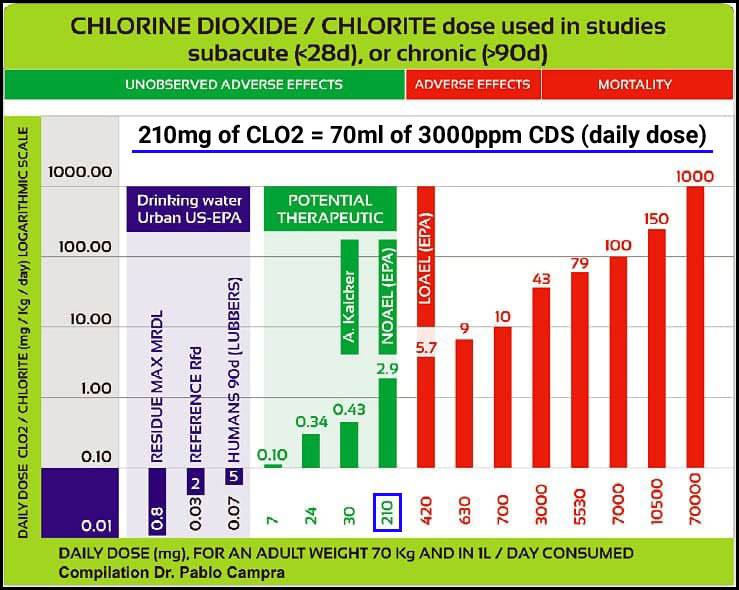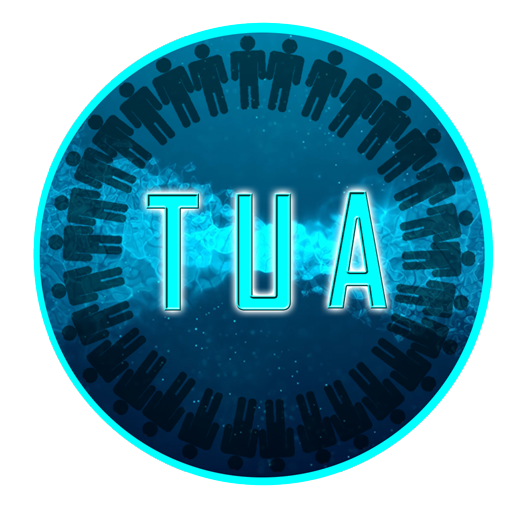Reason #1
Chlorine Dioxide is safe and is not harmful when used at therapeutic doses because many studies on the safety and toxicity of Chlorine Dioxide have been carried out, and these studies clearly define the safety limits of Chlorine Dioxide. The EPA, WHO, and CDC have documented this in their own publications. The No Observed Adverse Effect Level (NOAEL) is established at 3 mg/kg/day. NOAEL is defined as the cumulative daily dose of a substance that can be given without seeing any adverse effects. Below is a graphic that summarizes the safety and toxicity data.

Here are some quotes from several of the safety and toxicity studies that have been done.
- “The absence of physiological complications in response to acute single-dose administration of chlorine dioxide and its byproducts to normal healthy adult males was demonstrated over a wide range of concentrations.” Effects of the acute rising dose administration of chlorine dioxide, chlorate, and chlorite to normal healthy adult male volunteers. J R Lubbers et al. J Environ Pathol Toxicol Oncol. 1984 Jul. https://pubmed.ncbi.nlm.nih.gov/6520727/
- “All three phases of this large controlled and double-blinded clinical evaluation of CLO2 and its potential metabolites in human male volunteer subjects work completed uneventfully. There were no obvious undesirable clinical sequela noted by any of the participating subjects or the observing medical team.” Study of chlorine dioxide and its metabolites in man (1981). https://nepis.epa.gov/Exe/ZyPDF.cgi/20016SZ3.PDF?Dockey=20016SZ3.PDF
- “In the subchronic oral toxicity test, 0, 5, 10, 20, and 40 ppm UC-1 was prepared to feed the mice. Clinical observations of the mice showed no abnormality and no mortality after 90 days for the control and test groups”. Efficacy and Safety Evaluation of a Chlorine Dioxide Solution (2017). Full HTML: https://www.ncbi.nlm.nih.gov/pmc/articles/PMC5369164/
- The governmental agency documents listed below provide a thorough review of toxicity data, and all three clearly indicate that the overall “no observed adverse effect level” NOAEL For oral consumption of chlorine dioxide is 3 mg/kg/day.
- CDC documentation: https://www.atsdr.cdc.gov/toxprofiles/tp160-c2.pdf
- WHO documentation: https://www.who.int/docs/default-source/wash-documents/wash-chemicals/chlorine-dioxide-chlorite-chlorate-background-document.pdf?sfvrsn=cab527bb_5
- EPA documentation (Section 5 Dose-Response Assessments pp 33-37): https://cfpub.epa.gov/ncea/iris/iris_documents/documents/toxreviews/0648tr.pdf
Reason #2
Chlorine Dioxide is safe and is not harmful when used at therapeutic doses because it’s safer than oxygen.
When used in therapeutic amounts (< 3 mg/kg/day), Chlorine Dioxide is safer than supplemental oxygen.
What makes any molecule that contains oxygen potentially harmful is its reduction potential, which is measured in volts (V). The higher the voltage, the greater the capacity to induce oxidative stress and damage to biological systems.
Oxygen has a standard reduction potential (voltage) of 1.3 V (Volts). Chlorine Dioxide, in contrast, has a standard reduction potential (voltage) of 0.95 V. This makes the potential for oxygen to cause oxidative damage and/or stress on biological systems higher than that of Chlorine Dioxide.
Antimicrobial strategies centered around reactive oxygen species – bactericidal antibiotics, photodynamic therapy and beyond. https://www.ncbi.nlm.nih.gov/pmc/articles/PMC3791156/
Material Compatibility (table of Standard reduction potentials (voltages) of ROS) https://www.clordisys.com/materialcompatibility.php
Reason #3
Chlorine Dioxide is safe and is not harmful because when used in therapeutic amounts (< 3 mg/kg/day), your body rapidly neutralizes it with its sophisticated antioxidant/redox system. However, within moments, viruses and bacteria can be easily destroyed by chlorine dioxide because most of them lack any such antioxidant system.
Antimicrobial strategies centered around reactive oxygen species – bactericidal antibiotics, photodynamic therapy and beyond. https://www.ncbi.nlm.nih.gov/pmc/articles/PMC3791156/
Oxidative Stress: Harms and Benefits for Human Health https://www.ncbi.nlm.nih.gov/pmc/articles/PMC5551541/
Reactive oxygen species, aging and the hormesis police https://www.ncbi.nlm.nih.gov/pmc/articles/PMC4332618/
Hormesis and Oxidative Distress: Pathophysiology of Reactive Oxygen Species and the Open Question of Antioxidant Modulation and Supplementation https://www.ncbi.nlm.nih.gov/pmc/articles/PMC9405171/
Reason #4
Chlorine Dioxide is safe and is not harmful because, just like ozone, which is an approved and accepted medical therapy, it is a therapeutic reactive oxygen species that, when used in therapeutic doses (< 3 mg/kg/day), can eliminate diseases that nothing else can. By the way, ozone must be used with greater caution because its standard reduction potential is very high compared to Chlorine Dioxide. The standard reduction potential of ozone is 2.07 V, in contrast to Chlorine Dioxide’s electric potential, which is 0.95 V.
The biological activity of medical ozone in the hormetic range and the role of full expertise professionals https://www.ncbi.nlm.nih.gov/pmc/articles/PMC9523567/
Mechanisms of Action Involved in Ozone Therapy: Is healing induced via mild oxidative stress?https://www.ncbi.nlm.nih.gov/pmc/articles/PMC3298518/
Reason #5
Chlorine Dioxide is safe and is not harmful because hundreds of thousands of people have used it safely and provided their own anecdotal reports and testimonies of its powerful effectiveness against many different kinds of disease processes.
You can read thousands of testimonials at the two locations listed below.
Location 1: https://mmstestimonials.co
Location 2: https://t.me/theuniversalantidote
Written by Curious Outlier
(Curious Outlier is anonymous. He is a registered nurse and has spent 25+ years in the medical field with a specialization in critical care. Curious Outlier produced a documentary about Chlorine Dioxide, which can be watched at https://theuniversalantidote.com)
*Disclaimer: This article is not meant to be used, nor should it be used, to diagnose or treat any medical condition. For diagnosis or treatment of any medical problem, consult your own physician. The publisher and author are not responsible for any specific health or allergy needs that may require medical supervision and are not liable for any damages or negative consequences from any treatment, action, application, or preparation to any person reading or following the information provided in this article. References are provided for informational purposes only and do not constitute an endorsement of any websites or other sources. Readers should be aware that listed website links may change.
